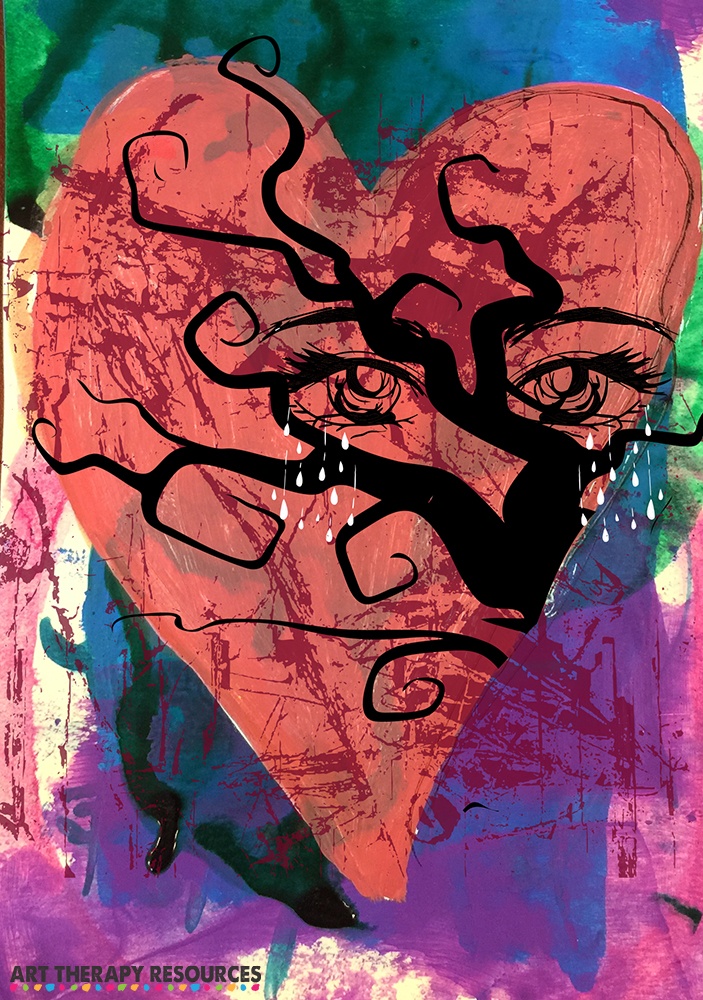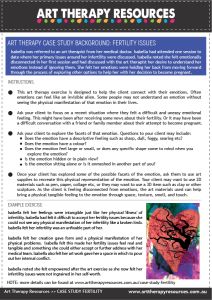THIS POST INCLUDES:
- Art Therapy and Fertility
- About the Client
- Current Client Issues
- Art Therapy Exercise
- Client Insight and Outcomes
- Disclaimer
- FREE DOWNLOAD Art Therapy Exercise
ART THERAPY AND FERTILITY
Fertility issues can create a multitude of difficult experiences and emotions for people. The issues that arise can occur in the pre-pregnancy stage where difficulties arise in getting pregnant, as well as post-pregnancy stage in the event a pregnancy loss.
Many of the emotions are similar for both stages, however. this blog post will focus primarily on the pre-pregnancy stage.
Once a couple or a woman decides to get pregnant, this can usually be a very exciting time when hopes, dreams, expectations are focused on the success of getting pregnant, however, for those who struggle with fertility issues, these hopes and dreams can begin to fade and a flood of emotions are left to deal with the stress and grief of pregnancy expectations not coming to fruition.
Attempts to get pregnant may follow a slower path that eventually leads to pregnancy, however, other people may have to eventually face the prospect of never becoming pregnant. In this instance, people may consider adoption, surrogacy, or choosing not to pursue having a child. Depending on where you live, your options for having a child (outside of becoming pregnant), may be different.
COMMON EMOTIONS AND ISSUES
Whatever path is chosen, the path to deal with emotions and thoughts is difficult. Not only are issues around your own fertility confronted you may also have to deal with emotions at seeing other people pregnant as well as the ongoing pressure that external family members may inadvertently present.
Some of the most common emotions that may arise during this period include:
The challenges of trying to conceive may also raise issues that relate to:
- Self-esteem
- Identity
- Values
- Body image
- Grief
- Interpersonal relationships
- Existential value
People who are experiencing infertility issues often feel locked in the struggle to remain hopeful for pregnancy yet feeling despondent over previous past attempts to get pregnant. It can become difficult to process to balance the emotions of sadness and grief yet maintaining a positive outlook for future attempts.
RELATIONSHIPS
Added to this complex balance of emotions, is the interplay of other family and friend’s emotions that may have an impact on the woman who is attempting to get pregnant. Infertility can play have a significant impact on interpersonal relationships.
People who are experiencing issues with fertility are often confronted with frustrated family members, or friends with well meaning advice, or alternatively peers who don’t seem to have problems getting pregnant multiple times. This can place a significant amount of pressure on relationships when the person experiencing infertility is not provided with the space to sit with their feelings and process their emotions over time.
This pressure often results in the person with infertility issues withdrawing from her social circle in an attempt to avoid the difficult discussions and emotions that occur when the issue of pregnancy arises.
HOW ART THERAPY CAN HELP WITH FERTILITY
Art therapy can help in the difficulties that arise through infertility issues. Benefits of art therapy for clients experiencing difficulty with infertility include:
- Expression of emotions
- Validating emotions
- Exploring relationship conflict
- Acceptance
- Release of stress
- Expression of grief and loss
- Developing awareness of emotions and thoughts
- Exploring choices and decision-making
- Developing self-worth
- Social connection with others who share the same experience
Fertility issues can be deeply personal. Often, women are dealing with an internal relationships conflict as they believe their body is failing them. This is different to external conflicts where some blame is shared between people who contribute to a problem. However, in the case of infertility, women can feel that they alone are the cause of their difficulty to get pregnant. Feelings and thoughts are often internalised and create a feeling of isolation from loved ones including partners.
Art therapy can help women beyond verbal expression and instead use art to explore internalised emotions and experiences from the woman’s perspective.
Art can help clients develop a visual image of the internal physical experiences that a woman can’t see occur with respect to her fertility issues. Art can help clients develop symbols and imagery that help her connect the medical physical experience of infertility with her emotional psychological experience.
ABOUT THE CLIENT
- Name: Isabella
- Age: 25
- Summary of sessions to date: Isabella was referred to an art therapist from her medical doctor. Isabella had attended one session to date where her primary issues around her infertility were discussed.
CURRENT CLIENT ISSUES
Isabella noted she felt emotionally disconnected in her first session and had discussed with the art therapist her desire to understand her emotions instead of ignoring them. She felt her emotions were holding her back from moving forward through the process of exploring other options to help her with her decision to become pregnant.
ART THERAPY EXERCISE
This art therapy exercise is designed to help the client connect with their emotions. Often emotions can feel like an invisible alien. Some people may not understand an emotion without seeing the physical manifestation of that emotion in their lives.
INSTRUCTIONS:
- Ask your client to focus on a recent situation where they felt a difficult and uneasy emotional feeling. This might have been after receiving some news about their fertility. Or it may have been a difficult conversation with a friend or family member about their attempt to become pregnant.
- Ask your client to explore the facets of that emotion. Questions to your client may include:
- Does the emotion have a descriptive feeling such as sharp, dull, foggy, searing etc?
- Does the emotion have a colour?
- Does the emotion feel large or small, or does any specific shape come to mind when you explore the emotion?
- Is the emotion hidden or in plain view?
- Is the emotion sitting alone or is it enmeshed in another part of you?
- Once your client has explored some of the possible facets of the emotion, ask them to use art supplies to recreate this physical representation of the emotion. Your client may want to use 2D materials such as pen, paper, collage etc, or they may want to use a 3D item such as clay or other sculpture. As the client is feeling disconnected from emotions, the art materials used can help bring a physical tangible feeling to the emotion through space, texture, smell, and touch.
CLIENT INSIGHT AND OUTCOMES
Isabella felt her feelings were intangible just like her physical ‘illness’ of infertility. Isabella had felt it difficult to accept her fertility issues because she could not see any physical manifestation of her infertility like a broken limb or visible skin rash. Isabella also felt her infertility felt ingrained in her body in a deep and pervasive way in which it could not be removed like a tumor or an appendix. She felt her infertility was an unfixable part of her.
Isabella felt that the art therapy exercise gave her an outlet for her internal conflict. Isabella felt her creation gave form and a physical manifestation of her physical problems. Isabella felt this made her infertility issues feel real and tangible and something she could either accept or further address with her medical team. Isabella also felt her artwork gave her a space in which to pour out her internal conflict.
Isabella noted she felt empowered after the art exercise as she now felt her infertility issues were not ingrained in her self-worth.

DISCLAIMER
This case study represents a snapshot of the client’s progress in treatment. The exercise in this article could be used as written or as a guide for new and original tasks developed by the Art Therapist. Responsibility for treatment resides with the individual therapist who understands their clients specific needs. The art therapy exercise should not be viewed as a pre-defined directive on how to treat a client that presents with a specific range of problems.This art therapy exercise will help build a database of knowledge to draw upon when helping your client. Art Therapy is associated with psychotherapy techniques, however each therapist often approaches therapy with their own foundation of psychological interventions, whether it be psychotherapy, CBT, DBT or other methods.
FREE DOWNLOAD: Art Therapy Exercise
Download the FREE Art Therapy Exercise based on the above Case Study. The free download includes instructions for the art therapy exercise, along with an example of the art therapy exercise.

BUILD YOUR ART THERAPY REFERENCE MATERIALS:
Pin this image to your Pinterest board.

SHARE KNOWLEDGE & PASS IT ON:
If you’ve enjoyed this post, please share it on Facebook, Twitter, Pinterest. Thank you!
